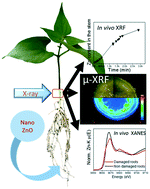当前位置:
X-MOL 学术
›
Environ. Sci.: Nano
›
论文详情
Our official English website, www.x-mol.net, welcomes your feedback! (Note: you will need to create a separate account there.)
Shedding light on the mechanisms of absorption and transport of ZnO nanoparticles by plants via in vivo X-ray spectroscopy
Environmental Science: Nano ( IF 7.3 ) Pub Date : 2017-10-16 00:00:00 , DOI: 10.1039/c7en00785j Tatiana N. M. da Cruz 1, 2, 3, 4 , Susilaine M. Savassa 1, 2, 3, 4 , Marcos H. F. Gomes 1, 2, 3, 4 , Eduardo S. Rodrigues 1, 2, 3, 4 , Nádia M. Duran 1, 2, 3, 4 , Eduardo de Almeida 1, 2, 3, 4 , Adriana P. Martinelli 1, 2, 3, 4 , Hudson W. P. de Carvalho 1, 2, 3, 4
Environmental Science: Nano ( IF 7.3 ) Pub Date : 2017-10-16 00:00:00 , DOI: 10.1039/c7en00785j Tatiana N. M. da Cruz 1, 2, 3, 4 , Susilaine M. Savassa 1, 2, 3, 4 , Marcos H. F. Gomes 1, 2, 3, 4 , Eduardo S. Rodrigues 1, 2, 3, 4 , Nádia M. Duran 1, 2, 3, 4 , Eduardo de Almeida 1, 2, 3, 4 , Adriana P. Martinelli 1, 2, 3, 4 , Hudson W. P. de Carvalho 1, 2, 3, 4
Affiliation

|
Several factors have contributed to bring pressure on agriculture. In this context, nanomaterial properties can be explored to design more efficient fertilizers and therefore increase productivity. In the present study, the roots of Phaseolus vulgaris were immersed in several nano ZnO dispersions for 48 h. The absorption and transport phenomena were in vivo monitored by X-ray fluorescence spectroscopy (XRF) and X-ray absorption spectroscopy (XAS). The nanoparticle size, concentration and coating with surfactants affected the rate of Zn release and therefore its uptake. In vivo X-ray absorption spectroscopy showed that Phaseolus vulgaris takes up Zn bound to both citrate and malate, while entire nanoparticles were only absorbed when roots were injured. X-ray fluorescence microanalysis unravelled that besides xylem bundles, root to shoot Zn transport can take place through the cortex.
中文翻译:

通过体内X射线光谱学阐明植物对ZnO纳米颗粒的吸收和转运的机理
有几个因素造成了对农业的压力。在这种情况下,可以探索纳米材料的特性来设计更有效的肥料,从而提高生产率。在本研究中,将菜豆的根浸入几种纳米ZnO分散液中48 h。通过X射线荧光光谱(XRF)和X射线吸收光谱(XAS)在体内监测吸收和转运现象。纳米颗粒的大小,浓度和表面活性剂涂层会影响锌的释放速率,从而影响锌的吸收。体内X射线吸收光谱显示菜豆吸收结合在柠檬酸盐和苹果酸上的锌,而整个纳米颗粒仅在根部受伤时被吸收。X射线荧光显微分析结果表明,除木质部束外,从根部到根部的Zn转运都可以通过皮层进行。
更新日期:2017-11-07
中文翻译:

通过体内X射线光谱学阐明植物对ZnO纳米颗粒的吸收和转运的机理
有几个因素造成了对农业的压力。在这种情况下,可以探索纳米材料的特性来设计更有效的肥料,从而提高生产率。在本研究中,将菜豆的根浸入几种纳米ZnO分散液中48 h。通过X射线荧光光谱(XRF)和X射线吸收光谱(XAS)在体内监测吸收和转运现象。纳米颗粒的大小,浓度和表面活性剂涂层会影响锌的释放速率,从而影响锌的吸收。体内X射线吸收光谱显示菜豆吸收结合在柠檬酸盐和苹果酸上的锌,而整个纳米颗粒仅在根部受伤时被吸收。X射线荧光显微分析结果表明,除木质部束外,从根部到根部的Zn转运都可以通过皮层进行。



























 京公网安备 11010802027423号
京公网安备 11010802027423号